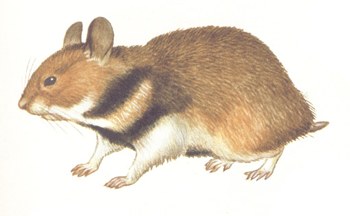Pests
Mesocricetus raddei Nehring. - Ciscaucasian Hamster or Georgian Hamster.
Systematic position.
Class Mammalia, order Rodentia, family Cricetidae, subfamily Cricetinae, genus Mesocricetus. Three subspecies are known, including the plain (ciscaucasian) subspecies that is probably an independent species with diploid chromosome set differing from that of mountain subspecies.Biological group.
Pest rodents.Morphology and biology.
Body length is to 280 mm, tail length is to 14.5 mm. Mountain subspecies are bigger than plain subspecies. On cheeks and behind ears there are small light spots separated by wide black stripe. Body is brown-ocherous from above; belly is black. Diploid chromosome set is 2n=44 (in the smallest plain subspecies it is 2n=42). This animal inhabits dry gramineous and forb steppes, and also mountain steppes at elevations from 1600 to 2300 m above sea level. Prefers settling on cultivated lands, especially sod fields. Constantly occurs in forest belts. M. raddei avoids water meadows and large forests.Distribution.
Within the Former Soviet Union this species occurs in the North Caucasus and Ciscaucasia. In the middle of the 20th century the extension of the area northward and north-westward has been registered in plains. In mountains the area remains practically stable.Ecology.
This species is active at dusk and night. In spring and summer it appears on the surface in the daytime as well. Burrows are deep, with several exits in mountain forms, and usually with one exit in plain (ciscaucasian) subspecies. The most intensive fossorial activity is observed in the period of migration of young animals. In spring and first half of summer this animal mainly feeds on grass vegetation. In autumn seeds of cereals, legume crops, and also root crops prevail in ration. It makes large stores for winter (to 16 kg and more) and falls into hibernation. Depending on altitude of place and on conditions of winter the hibernation lasts 4 to 6 months. The main part of store is used in spring after coming out of hibernation. In the mountains, this animal breeds twice a year, and 3-4 times in the plains. There are 4 to 20 young hamsters in a brood (even to 24 according to some evidence), about 12 on average. Population density fluctuates considerably over years and seasons, but is restored quickly because of high reproduction intensity.Economic significance.
In some years M. raddei becomes a noticeable pest of agricultural crops. It harms grain crops, perennial grasses, potato plantings, melon fields, and vegetable gardens. Vegetation is completely destroyed within a burrow; the size of damaged plots ("bald patches") reaches 50 m2 and more. In some places this animal is hunted for its fell, which are used as furs. It has epidemiological significance in reservation and transmission of tularemia infection. The main control measure of M. raddei is trapping and forceing it out of burrows by water.Reference citations.
Beme L.B. 1925. To biology and distribution of some rodents of the North Caucasus. Vladikavkaz: Severo-Kavkazskaya kraevaya stantsiya zashchity rastenii. 15 p. (In Russian)Dyukov N.N. 1927. Dagestanian hamster. Makhach-Kala: Izd.Dagestanskogo NII i Dagnarkozema. 8 p. (In Russian)
Gromov I.M., Erbaeva M.A. 1995. Mammals of the fauna of Russia and adjacent territories. Leporids and Rodents. In: Aristov A.A., Baranova G.I., editors. Keys to fauna of Russia, published by Zoological Institute of RAS, Issue 167. Saint Petersburg: ZIN RAN. 552 p. (In Russian)
Magomedov M., Omarov K.Z. 1995. The peculiarities of nutrition and condition of natural population of ciscaucasian hamster (Mesocricetus raddei avaricus) in agricultural landscapes of mountain Dagestan. Zoologicheskii zhurnal, 74(3): 123-133. (In Russian)
Yakovlev M.G., Kolesnikov I.M. 1954. Some new data on distribution and ecology of ciscaucasian hamster in Rostov region. Zoologicheskii zhurnal, 33(3): 693-701. (In Russian)


